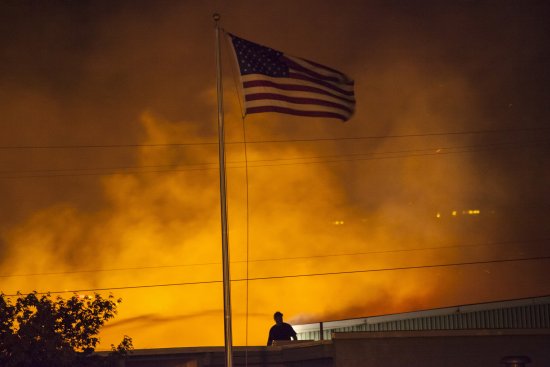
An exceptionally hot and dry summer has contributed to a spike in seasonal fires
Wildfires in various stages of containment continued to consume Washington state Wednesday, with major fires also burning throughout the west in Idaho, California, British Columbia and Saskatchewan.
There are 21 fires burning in Washington and Oregon alone, NBC News reports, with an additional 100 just over the Canadian border.
The weekend of July 4 was the hottest on record in western Washington, local station KREM reports, and the area has just tied the record for most consecutive days of above 90°F temperatures. As a result, there have been close to 400 wildfires already reported this July compared with 275 for the same month last year, according to the state’s Department of Natural Resources.
[time-brightcove not-tgx=”true”]The red portion of the map highlights the volatility of the area around the Washington-Idaho border, which saw multiple fires start this week. A conflagration raged in Cape Horn, Idaho over as much as 2,000 acres, and over the border in Spokane evacuations just outside the city ordered residents to be ready to leave at a moment’s notice after a fire threatened an area popular with hikers, KREM reports.
Elsewhere, the so-called “Paradise Fire” continued to burn in the depths of Olympic National Park, usually one of the wettest places in the country, with the blaze still only 21% contained after several weeks. And further south close to the Oregon border, the so-called “Gilmore Gulch” fire continued its slow march. Local station KXLY reports that the fire had consumed more than 5,000 acres and was only 10% contained by Tuesday.
Linda Weatherly, a fourth generation rancher whose property was at risk if the fire continued its advance, said she could not remember a summer so dry and was deeply concerned about what the next week might hold. “It’s our livelihood,” she told TIME. “We have animals and crops. And they’re talking about thunderstorms now… it would devastate families.” Should the fire approach, she said her first priority would be to “try to get my animals out of here. I don’t have any water to fight it. It would have to be, you know… all the ranchers try to kick in and help.”
Eric Beckemeir, a waiter at the Idle Hour Eatery near Quincy, Wash., reported similar reactions from his neighbors when a fire consumed 10,000 acres north of town after the July 4 holiday before being contained. The town is 30 miles southeast of Wenatchee, where the Sleepy Hollow fire destroyed dozens of homes earlier this week, and several of its own houses were temporarily evacuated during the fire. But Beckemeir told TIME the community came together to help: local businesses donated water and gatorade, farmers used their tractors to make fire lines, and orchardists sprayed their neighbors’ homes down with hoses. “In a rural area you can take care of each other,” he said.
The Most Beautiful Wildfire Photos You’ll Ever See









